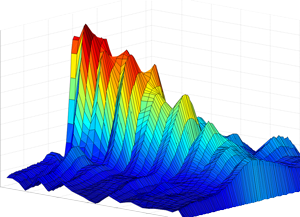Remote identification of liquids in a dielectric container using millimeter waves. 2. Linear scanning
DOI:
https://doi.org/10.3103/S0735272718040039Keywords:
short-range radar, radiometric system, thermal portrait, polarization of the electromagnetic wave, refined products, petrol, diesel fuelAbstract
The results of experimental studies showing the applicability of short-range radar in the millimeter wavelength range for remote identification of explosive liquids in closed dielectric containers are presented. This study presents radiometric study of hazardous liquids based on an example of gasolines and diesel fuels. It has been shown experimentally that radiometric studies allow remote studies and object identification at distances of up to several meters. The variety of physical and chemical properties of liquid fuels does not allow their identification using the measurement results of only the permittivity and loss tangent from one measurement in one frequency range. The use of a thermal portrait of liquid fuels in closed dielectric containers for their identification is more illustrative and informative. The dependence of the spatial temperature portrait of the container with liquid on the polarization of the received signal is experimentally shown. The use of different polarizations of the received signal and the difference in the spatial temperature portraits of the liquid in the container provide additional information in order to increase the probability of correct identification of the liquid. Thermal portraits obtained with linear scanning for gasolines of different manufacturers differ more strongly, in comparison with thermal portraits of diesel fuels. Due to the modification of the measuring system, the total time for scanning and obtaining the output experimental data is 42 s. The standard deviation of the obtained experimental data did not exceed 3.6%.References
- PAVLYUCHENKO, A.V.; LOSHITSKIY, P.P.; SHELENGOVSKIY, A.I.; BABENKO, V.V. “Remote identification of liquids in a dielectric container using millimeter waves. 1. Principal possibility,” Radioelectron. Commun. Syst., v.60, n.10, p.423-430, 2017. DOI: https://doi.org/10.3103/S0735272717100016.
- IOFFE, B.A. Reflectometric Methods in Chemistry, 2nd ed. [in Russian]. Leningrad: Khimiya, 1974.
- HADDEN, N.; BAUMANN, F.; MCDONALD, F.; MUNK, M.; STEVENSON, R.; GERE, D.; ZAMARONI, F. Basic Liquid Chromatography. Walnuk Greek, Calif.: Varian Aerograph, 1971.
- NESMEYANOV, A.N.; NESMEYANOV, N.A. Fundamentals of Organic Chemistry. Book 1 [in Russian]. Moscow: Khimiya, 1969.
- SMIRIDOVICH, E.V. Technology of Oil and Gas Refining, Vol. 2 [in Russian]. Moscow: Khimiya, 1968.
- PISARENKO, A.N.; KHAVIN, Z.Y. Course of Organic Chemistry, 4th ed. [in Russian]. Moscow: Vyssh. Shkola, 1985.
- KING, R.W.P.; SMITH, G.S. Antennas in Matter: Fundamentals, Theory, and Applications. Book 1. MIT Press, 1981.
- ZELKIN, E.G.; PETROVA, R.A. Lens Antennas [in Russian]. Moscow: Sov. Radio, 1974.
- KONDRATENKO, G.S.; FROLOV, A.Y. Radiovision. Radar Systems of Distant Earth Probing: Book for higher educational institutions [in Russian, ed. by G. S. Kondratenko]. Moscow: Radiotekhnika, 2005.
- DIVIN, Y.; LYATTI, M.; POPPE, U.; URBAN, K. “Identification of liquids by high-Tc Josephson THz detectors,” Physics Procedia, v.36, p.29-34, 2012. DOI: http://doi.org/10.1016/j.phpro.2012.06.125.
- VASSILIKOV, A.; KALOGERAS, I.M. “Dielectric analysis (DEA),” in: MENCZEL, Joseph D.; PRIME, R. Bruce. Thermal Analysis of Polymers: Fundamentals and Applications. Wiley & Sons, Inc., 2009.

Downloads
Published
2018-04-27
Issue
Section
Research Articles

